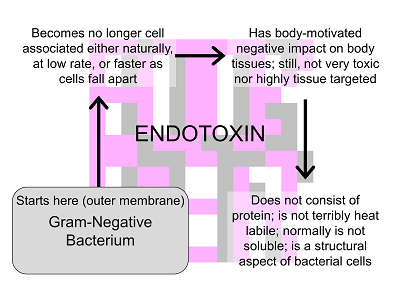∞ generated and posted on 2016.03.18 ∞
Lipid A portion of lipopolysaccharide that the body uses as one target for detecting and then reacting to bacterial infections.
| Endotoxin is an aspect of the membranes (outer membranes) of certain bacteria and serves as a warning to our bodies that these bacteria are present; our bodies can overreact to endotoxin, which is why it is called a toxin. |
Endotoxin can lead to septic shock if present in the blood even in small quantities. See by contrast exotoxin.

Figure legend: Flowchart (of sorts) indicating the various properties of endotoxins and particularly in terms of what differentiates them from exotoxins.
From :
Endotoxins are lipopolysaccharides (LPS) derived from cell membrane of Gram-negative bacteria and are responsible for its organization and stability. In it is possible to find endotoxins during production processes or in the final product. Although endotoxins are linked within the bacterial cell wall, they are continuously liberated into the environment. The release does not happen only with but also during growth and division. Since bacteria can grow in media, such as water, , and buffers, endotoxins are found almost everywhere. A single Escherichia contains about 2 million LPS molecules per cell. Endotoxin elicits a wide variety of . In conditions where the body is exposed to LPS excessively or (as when small concentrations of LPS enter the ), a can occur, leading to multiple pathophysiological effects, such as , , and . However, endotoxin does not act directly against cell or organs but through activation of the , especially through monocytes and macrophages, with the release of a range of , such as (TNF), and . and shock are induced in mammals upon of endotoxin at low concentrations (1 /) .